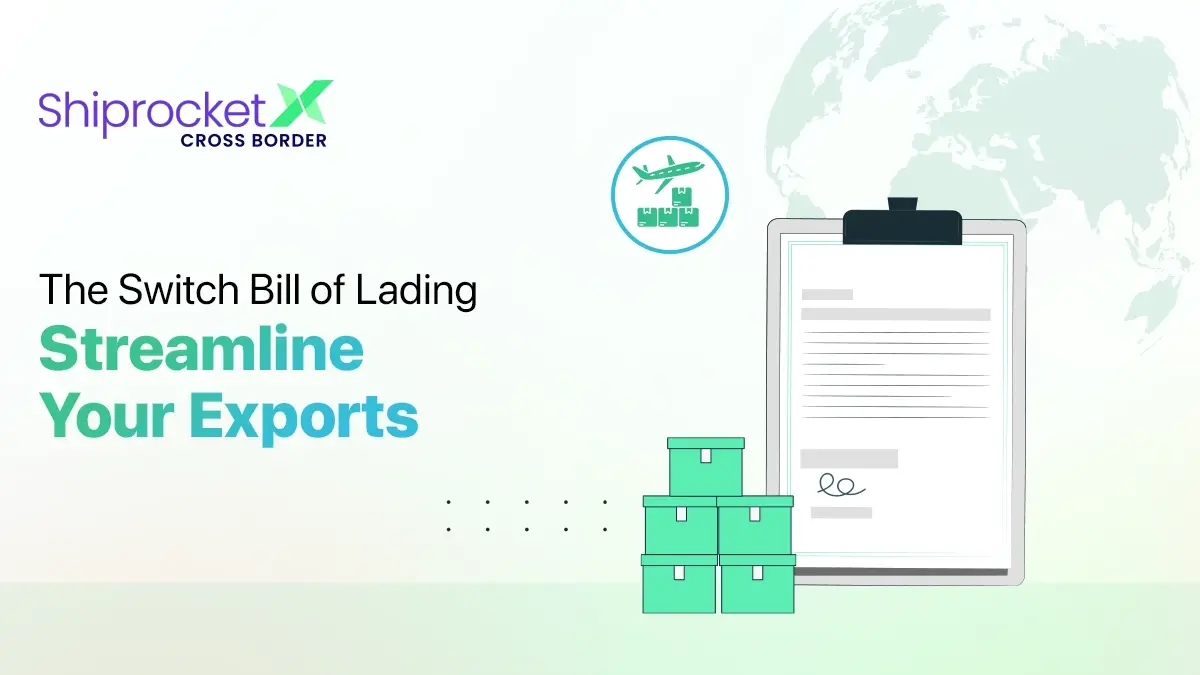Export Incentives in India: Types & Benefits
- What are Export Incentives?
- How Export Incentives Work?
- Who Executes Export Incentives?
- Benefits of Export Incentives
- Types of Export Incentives in India
- 1. Advance Authorization Scheme
- 2. Advance Authorisation For Annual Requirement
- 3. Duty Drawback Scheme (DBK) For Customs, Central Excise, And Service Tax Incentives for Exporters
- 4. Service Exports from India (SEIS) Scheme
- 5. Duty-Free Import Authorization (DFIA) Scheme
- 6. Zero Duty EPCG (Export Promotion Capital Goods) Scheme
- 7. Post Export EPCG Duty Credit Scrip Scheme
- 8. Towns Of Export Excellence (TEE)
- 9. Market Access Initiative (MAI) Scheme
- 10. Marketing Development Assistance (MDA) Scheme
- 11. Duty Entitlement Passbook (DEPB) Scheme
- 12. Interest Equalisation Scheme (IES)
- 13. Transport and Marketing Assistance Scheme (TMA)
- 14. (Goods and Services Tax) GST Refund for Exporters
- 15. Niryat Rin Vikas Yojna (NIRVIK) Scheme
- 16. Rebate on State and Central Taxes and Levies (RoSCTL) Scheme
- 17. Export Oriented Units (EOU) Scheme
- 18. Merchandise Exports From India Scheme (MEIS) Replaced with RoDTEP (Rebate of Duties & Taxes on Export Products Scheme)
- Elevate your Business by Exporting your Products with ShiprocketX!
India’s economy is one of the fastest-growing in the world. As part of economic reforms, the government has formulated many policies that have led to the country’s gradual economic development. Under the changes, there has been an initiative to improve the condition of exports to other countries.
In this regard, the government has taken a few actions for the benefit of businesses in the export trade. The primary objective of these actions is to simplify the whole export process and make it more flexible.
On a broader scale, these reforms have been a blend of both social democratic and liberalisation policies, providing incentives to exporters in the form of duty credit scrips to refund losses on paid duties. Some of the major types of export incentive schemes are:
- Advance authorization scheme
- Advance authorization for annual requirement
- Duty Drawback (DBK) Scheme for customs, central excise, and service tax incentives for exporters
- Service Exports from India (SEIS) Scheme
- Duty-free Import Authorization (DFIA)
- Zero-duty EPCG scheme
- Post export EPCG duty credit scrip scheme
- Towns of Export Excellence
- Market Access Initiative
- Market Development Assistance Scheme
- Export Oriented Units (EOU) Scheme
- Rebate on State and Central Taxes and Levies (RoSCTL) Scheme
- Niryat Rin Vikas Yojna (NIRVIK) Scheme
- (Goods & Services Tax) GST Refund for Exporters
- Transport and Marketing Assistance Scheme (TMA)
- Interest Equalisation Scheme (IES)
- Duty Entitlement Passbook (DEPB) Scheme
- Merchandise exports from India scheme replaced with Rebate of Duties and Taxes on Export Products Scheme
Since the initiation of the liberalisation plan in the 1990s, economic reforms have emphasised open-market economic policies. Foreign investments have come in various sectors, and there has been good growth in the standard of living, per capita income, and Gross Domestic Product. Moreover, there has been a greater emphasis on flexible business and doing away with excessive red-tapism and government regulations.

What are Export Incentives?
Export incentives are provided to exporters as an acknowledgement of bringing in foreign exchange and encouraging them to export specific goods or services. These incentives are a form of economic help the government offers to businesses that facilitate securing foreign markets.
Under the Foreign Trade Policy, numerous schemes provide promotional measures in India to amplify exports. The objective is to offset infrastructural inefficiencies and related costs and provide exporters with a level playing field.
How Export Incentives Work?
To increase competitiveness in the global market, the government demands lower taxes on export goods. It helps make domestic exports competitive by providing rebates in terms of export incentives to the exporter. The incentives offered ensure a wider reach of local products and a surge in the Indian export business.
Let us understand this with one of the export incentives examples: when the government gives a tax rebate, the exporter can reduce the product’s price. This helps increase the product’s competitiveness globally and ensures a wider reach.
Export incentives also rely on the availability of the goods. This means that if there is surplus production of a particular product, the government might offer an export incentive to avoid wastage of the goods.
Who Executes Export Incentives?
The DGFT mostly executes the export incentives under the Commerce and Industrial Ministry in India. Furthermore the Central Board of Indirect Taxes and Customs (CBIC) frames policy associated with levying and collecting customs duty, different export fees, penalties, and Goods and Services Tax (GST).
The Reserve Bank of India, the country’s central bank, implements financial incentives related to exports. Additionally, the Directorate General of Export Promotion (DGEP) handles all export refund-related issues, handles policy matters associated with the export promotion scheme, and advises changes or revisions related to customs-related processes and policies.
It is important to know that the World Trade Organisation (WTO) handles any dispute among countries over the level of government involvement or any policy in foreign trade.
As a rule, the WTO can prohibit government incentives except those put into practice by least-developed countries. Therefore, all government incentives must be in regulation with the WTO, as they keep a check on legal and ethical world trade practices.
Benefits of Export Incentives
A country’s success depends on its manufacturers. If it gets various government export incentives to produce those goods that can be exported to foreign markets, economic growth can be ensured.
Export incentives not only help the exporters reduce prices but also benefit the country by increasing exports and boosting the economy. Here are some of the export incentive benefits that an exporter can avail of:
- Foreign Exchange: Exports bring in foreign currency. An increase in the export sector can significantly attract foreign direct investment (FDI).
- Every country must maintain a foreign exchange reserve to facilitate international trade transactions, pay debt, or pay for imports. By providing export incentives, governments encourage businesses to increase exports, which helps the country improve its foreign reserves and meet all its foreign obligations and liabilities.
- Job Creation: An increase in exports helps businesses grow, which creates employment. Export-oriented industries generate many jobs, exhilarating economic activity and propelling income growth.
- Businesses that export goods are also more focused on meeting international quality standards, which boosts innovation and employee skill development, augmenting companies’ competitiveness.
- Higher Wages: According to the World Bank report, an increase in exports creates higher wages, particularly for skilled, experienced, and urban workers. Increased exports could also lead to a shift in workers, especially low-skilled, from the informal sector to formal-sector jobs with increased wages and added benefits.
- Diversification: Increased export incentives will encourage more exports. These incentives help businesses reach different countries, which helps reduce the risks associated with fluctuations.
- Increased exports will also allow the country to diversify the market and reduce the reliability on a single industry or market. For example, if you export to different countries, even if the demand in one country goes down, you have other countries wherein you can increase the supply. This diversification protects businesses and the economy from potential slump, providing stability and sustained growth.
- Increased Profits: The major advantage of export incentives in India is profitability. Exporting gives you access to a global market of buyers, which means increased sales and profits.
- Reaching potential customers across the globe has always been challenging. However, with the increase in the eCommerce sector, gaining market access and selling your goods abroad has become easier. Thus, you can increase sales by leveraging eCommerce platforms by reaching customers in different countries.
Types of Export Incentives in India
The Indian government provides various export incentives to keep domestic products competitive globally. Some of the most common export incentives include direct payments, export subsidies, tax exemption on export profits, low-cost loans, and government-financed international advertising.
Let’s discuss different export incentive schemes in India in detail:
1. Advance Authorization Scheme
As part of this scheme, businesses are allowed to import input in the country without having to pay duty payment, if this input is for the production of an export item. Moreover, the licensing authority has fixed the value of the additional export products to not below 15%. The scheme typically has a validity period of 12 months for imports and 18 months for carrying out the Export Obligation (EO) from the date of issue.
Under this scheme, an exporter also gets the cost of inputs, fuel, or packaging material spent in producing an export product. However, the quantity of input for a given product is based on particular criteria, which may include the waste generated in the manufacturing process.
2. Advance Authorisation For Annual Requirement
Under the Advance Authorisation Scheme, exporters are authorised to import duty-free inputs, which are physically integrated into the export product. However, only the exporters who have a previous export performance for at least two financial years can avail of the Advance Authorization for Annual Requirement scheme and its export benefits in India.
3. Duty Drawback Scheme (DBK) For Customs, Central Excise, And Service Tax Incentives for Exporters
Duty Drawback is a time-tested scheme administered by the Central Board of Indirect Taxes and Customs (CBIC) to encourage exports. This scheme grants a rebate in the customs and central excise duties, levied on imported and excisable goods, respectively, when used as inputs for goods to be exported.
Availing the benefits of this scheme allows exporters to get a refund for the duty or tax paid for inputs against the exported products. This refund is carried out in the form of a Duty Drawback.
In case the Duty Drawback scheme is not mentioned in the export schedule, exporters can approach the tax authorities to get a brand rate under this scheme.
4. Service Exports from India (SEIS) Scheme
In the case of specified output services for export goods, the government provides rebates or discounts on service tax amount to exporters. The SEIS scheme was implemented to encourage sellers who export notified services.
Under this scheme, service exporters can apply for a refund or reimbursement from the government for the amount they paid as service tax on different products and services. However, this incentive ranges between 3% and 7% of the net foreign exchange earnings.
To avail of the benefit of this scheme, exporters are required to have an active IEC (Import-Export Code) with minimum net foreign exchange earnings of Rs. 11 lakhs (circa).
5. Duty-Free Import Authorization (DFIA) Scheme
This is also one of the export incentive schemes the government has introduced by combining the DEEC (Advance Licence) and DFRC to help exporters get free imports of certain products. This scheme allows exporters to make normal allowance for wastage, fuel, energy, catalyst, etc.
6. Zero Duty EPCG (Export Promotion Capital Goods) Scheme
EPCG scheme, applies to exporters of electronic products. Under this scheme, the import of capital goods for production, pre-production, and post-production is allowed at zero percent customs duty if the export value is at least six times the duty saved on capital goods imported. The exporter needs to verify this value (Export Obligation) within six years of the issuing date.
7. Post Export EPCG Duty Credit Scrip Scheme
Under the Post Export EPCG Duty Credit Scrip Scheme, exporters who aren’t sure about paying the export obligation can obtain an EPCG licence and pay the duties to the customs officials.
The EPCG duty credit script is issued to the exporters who import capital goods by making payment of duties through cash. Once they fulfil the export obligation, they can claim a refund of the taxes paid.
8. Towns Of Export Excellence (TEE)
Towns that produce and export goods above a particular value in the identified sectors are known as Towns of Export Excellence (TEE). These towns will be given a special status based on their performance and potential in exports that make substantial contributions to the country’s exports and help nations reach new markets.
9. Market Access Initiative (MAI) Scheme
Market Access Initiative Scheme is an Export Promotional Scheme that significantly promotes India’s exports.
This scheme came into action to provide financial guidance to eligible agencies for undertaking direct and indirect marketing activities like market research, capacity building, branding, and compliance in importing markets.
10. Marketing Development Assistance (MDA) Scheme
The Marketing Development Assistance (MDA) scheme aims to promote export activities abroad, assist different types of export promotion councils to develop their products, participate in international exhibitions, and buyer-seller meets abroad, and carry out other marketing activities abroad.
11. Duty Entitlement Passbook (DEPB) Scheme
The Duty Entitlement Passbook Scheme was introduced to neutralise customs duty on the import content of the export product. The government of India issues this scheme to benefit exporters by granting them duty credit against the export product.
12. Interest Equalisation Scheme (IES)
The Interest Equalisation Scheme was first implemented in 2015 to provide pre- and post-shipment export credit to exporters in rupees. Under this scheme, all qualified exporters benefited from financial assistance. This scheme offers all manufacturers in the MSME sector 5% interest and 3% financial support in 416 tariff lines.
13. Transport and Marketing Assistance Scheme (TMA)
The primary objective of the Transport and Marketing Assistance Scheme is to boost the Indian agricultural sector and make related products more competitive in international markets. The TMA scheme focuses on mitigating the high cost of transportation and providing marketing support for this industry.
14. (Goods and Services Tax) GST Refund for Exporters
GST Act offers some beneficial schemes to the exporters:
- IGST Refund: Exporters are entitled to get a refund for the integrated GST they initially paid on export goods. The customs department provides this refund.
- LUT Bond Scheme: By obtaining an LUT (Letter of Undertaking) bond, exporters can export goods without paying GST.
- 1% GST Benefit for Merchant Exporters: Merchant exporters can export goods from local suppliers at a 1% concessional GST rate.
15. Niryat Rin Vikas Yojna (NIRVIK) Scheme
The NIRVIK Scheme aims to simplify the claim settlement process for exporters. It was introduced by the ECGC (Export Credit Guarantee Corporation of India) to provide high insurance cover, facilitate loan lending, and reduce premiums for small exporters. With this scheme, many small-scale exporters were seamlessly disbursed credit.
16. Rebate on State and Central Taxes and Levies (RoSCTL) Scheme
The RoSCTL scheme facilitated exporters of manufactured goods and garments in reimbursing the embedded state and central taxes and levies. Introduced in 2019, this scheme grants refunds on taxes for transportation fuel, electricity duty, captive power, and mandi tax.
17. Export Oriented Units (EOU) Scheme
Introduced in 1980, the EOU scheme aims to increase exports by attracting investment for export production, generating additional employment, and enhancing foreign exchange earnings. Under this scheme, exporters are eligible to get a few waivers and concessions in compliance and taxes to the exporters. However, only the companies that can export 100% of their produced goods are allowed to set up an EOU.
18. Merchandise Exports From India Scheme (MEIS) Replaced with RoDTEP (Rebate of Duties & Taxes on Export Products Scheme)
The Merchandise Exports From India Scheme applies to the export of certain goods to specific markets. This scheme was designed to reward exporters in offsetting infrastructural inefficiencies and associated costs. Rewards for exports under MEIS were payable as a percentage of realised FOB value. This scheme was applicable till 30th December 2020.
The new RoDTEP scheme, which came into effect from 1 January, 2021, helps claim the benefit that has been manifested on the shipping bills. This scheme offers funding up to 90% to make it easy for MSMEs to enter the export market and participate in overseas fairs/trade delegations.
RoDTEP scheme was designed to neutralise the taxes and duties suffered on export goods which are otherwise not remitted, refunded, or credited in any manner.
You can easily apply for this scheme once you have obtained the Importer-Exporter Code (IEC), which is a 10-digit code issued by the Director General of Foreign Trade (DGFT). This code has lifetime validity.
Elevate your Business by Exporting your Products with ShiprocketX!
These export incentives have contributed significantly in promoting global trade and exports worldwide. Moreover, they have created a favourable atmosphere in the business community by lowering production costs, increasing competitiveness, and providing access to new markets. The government is also upcoming with many other benefits to strengthen the export sector of the country further with tax breaks, subsidies, and export credit guarantees.
However, major factors to consider when exporting your goods or services overseas are the cost and reliability of the shipping service provider you choose. An increase in transport costs can reduce your business’ export values, which is further traced back to a reduction in the number and size of shipments. With ShiprocketX, you get the best-in-class transport services, no matter what corner of the world you want to ship your products.
This leading cross-border shipping company is India’s most reliable and low-cost platform, helping your business drive sales by frequent bulk shipping.





Thanx a lot. This info helped me a lot.
Can you please also write the benefits for export of services (example: Technical Consulting Services, Software consulting services).
Please tell me how to export small consignment below ₹50000 for online orders
– How to collect payment.
– Bank or other charges. Etc.
– Post shipment obligations/ documentation if any.
In short please explain the procedure from receipt of order to despatch of goods and post shipment formalities
Thanks
Adil
Nice article Thank you for sharing the information. It helps a lot.This is really a great job you have done.
Thank you so much for writing such amazing an article. This has helped a lot. it has provided a good piece of information.Hope to read many such articles in future as well. Keep writing and sharing.
Me export karna chahta hu mujhe iec code number pana chahta hu
Hi Junaid,
IEC code banwane ke liye, aap idhar jankari paa sakte hai – http://bit.ly/322Fvqu
Srishti Arora